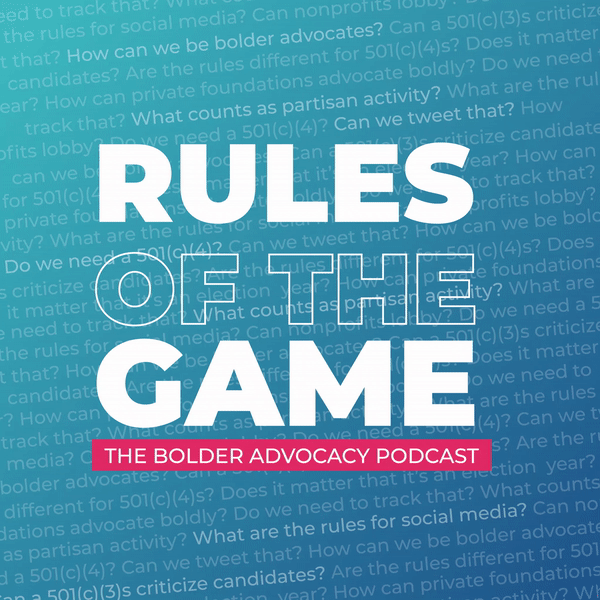This is my new podcast for Alliance for Justice on nonprofit advocacy laws. Please note that AFJ is a 501(c)(3) organization and my personal opinions expressed on tim-mooney.com and other social media platforms are not the opinions of AFJ.
—-
Can 501(c)(3)s advocate to advance their mission while remaining nonpartisan during an election year? Tim, Leslie and Quyen explain the factors that the IRS looks at, and use a recent example to show how small changes in the content or context of a communication can change things.
Our attorneys for this episode
Shownotes
- The one rule 501(c)(3)s need to know during election year — 501(c)(3)s cannot support or oppose candidates for public office.
- An election year is a great opportunity to elevate the issues your nonprofit works on every day. There are so many ways nonprofits can engage with voters, candidates and elected officials.
- Think of your advocacy like a road – there’s plenty of room to maneuver but this rule sets up guardrails you can’t cross.
- But the guardrails define the legal advocacy that can happen on the metaphorical road, so we start there. 501(c)(3)s cannot support or oppose candidates for public office, which means their activities must be nonpartisan.
- To determine whether or not a 501(c)(3) is nonpartisan, the IRS looks at all of the facts and circumstances. This is a subjective, risk analysis that takes into accounts everything the organization is saying and the context in which it’s saying that.
- Six things the IRS looks at in the facts & circumstances analysis:
- Track record of advocacy
- Timing relative to election
- Electoral or non-electoral factor driving the activity/communication
- References to candidate/election or comparing candidate positions.
- Is your message targeting for electoral or non-electoral reasons
- Wedge issues
- Context matters, but intent does not. This is an exercise in risk analysis, so we use a stop light analogy – red light is risky, green light low or no risk, and yellow light somewhere in between.
Example
Source: Earthjustice tweet of July 2, 2020.
- Our analysis: this was low-to-no risk tweet. Let’s go through a facts & circumstances analysis to understand why.
-
- Earthjustice’s track record of advocacy
- Mentioning a candidate, but out of context of the election
- Timing of the communication is far away enough from the election
- Communication based on non-election trigger (ongoing litigation)
- How do changes in timing and language affect the analysis?
-
- The same communication in late October may be higher risk unless the timing were linked to something independent of the election (such as a court opinion right then)
- But replace the reference to the Trump administration with the named defendant Army Corps of Engineers and the risk lowers again.
- Some additional language may make things much riskier, like adding a hashtag #RememberInNovember or some other implicit or explicit link to the election.
Resources
- Election Checklist for 501(c)(3) Public Charities: Ensuring Election Year Advocacy Efforts Remain Nonpartisan
- Election Year Activities for 501(c)(4) Social Welfare Organizations
- Bolder Advocacy’s technical assistance: 866-NP-LOBBY
- Email us at advocacy@afj.org
- Our website is bolderadvocacy.org
